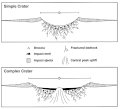H. Jay Melosh | |
|---|---|
 | |
| Born | June 23, 1947 |
| Died | September 11, 2020 (aged 73) |
| Citizenship | United States |
| Education | Princeton Caltech |
| Known for | Impact Cratering Studies |
| Awards | Barringer Medal (1999) G K Gilbert Award |
| Scientific career | |
| Fields | Geophysics |
| Institutions | Purdue University |
| Website | eaps.purdue.edu/people/faculty-pages |
H. Jay Melosh (June 23, 1947 – September 11, 2020) [1] was an American geophysicist specialising in impact cratering. He earned a degree in physics from Princeton University and a doctoral degree in physics and geology from Caltech in 1972. [2] His PhD thesis concerned quarks. [3] [4] Melosh's research interests include impact craters, planetary tectonics, and the physics of earthquakes and landslides. His recent research includes studies of the giant impact origin of the Moon, the Chicxulub impact that is thought to have extinguished most dinosaurs, and studies of ejection of rocks from their parent bodies. He was active in astrobiological studies that relate chiefly to the exchange of microorganisms between the terrestrial planets (a process known as panspermia or transpermia [5] ).
Contents
Melosh was a member of the American Geophysical Union, Geological Society of America, Meteoritical Society, American Astronomical Society (Division of Planetary Sciences,) and the American Association for the Advancement of Science. [2] He was the recipient of the Barringer Medal of the Meteoritical Society for his work on the physics of impact, and of the G. K. Gilbert Award from the Geological Society of America. He was elected to the National Academy of Sciences in 2003. [6]

